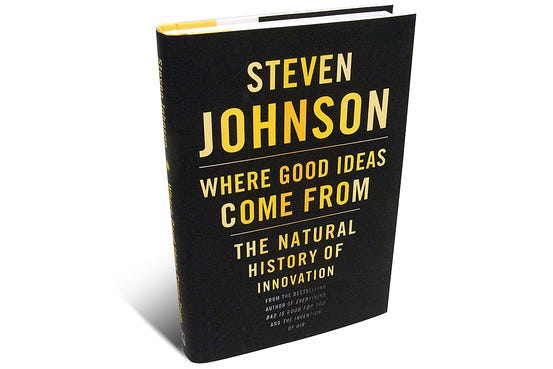Welcome to Polymathic Being, a place to explore counterintuitive insights across multiple domains. These essays take common topics and investigate them from different perspectives and disciplines to come up with unique insights and solutions.
Today's topic is part book review and part exploration into the foundational elements of the Polymathic Mindset. Namely that innovation occurs across and between domains and disciplines and is, more often, not found in silos of expertise. It’s a finding that’s only counterintuitive because of the myths about innovation permeating our cultures. Yet these myths end up falling apart on closer scrutiny.
This is Part 5 of the Keys to Innovation Series. You can find the other Keys here:
Part 1: Embrace the Divergents
Part 2: Face the Fear
Part 3: Rethink the Wisdom of Crowds
Part 4: Brain Stretch
I recently finished a book by Steven Johnson titled “Where Good Ideas Come From.” From cover to cover, it’s a treatise of Polymathic Thinking. Good ideas come from the network effect of dozens, if not hundreds of people across multiple domains and disciplines. Everything from the discovery of the double helix of DNA to the revolutionary Origin of Species by Charles Darwin is a testament to breaking out of specific expertise and weaving together ideas from other, often obscure areas.
Yet to understand how powerful this key to innovation that collaboration entails is, we must first address the reason we fixate on the myth of individual genius. Enter book two for consideration: “The Straight A Conspiracy.” Co-authored by Hunter Maats and Katie O’Brien, this book is targetted for any middle to high-schooler you know and contains a ton of value for all ages. One thing that’s addressed in the first chapters is the mythos that’s created around transformative personalities.
For example, Edison did not invent the lightbulb; his contribution was to an improved carbon filament that made lightbulbs more robust. He’s also noted for being on over a thousand patents but that’s a perk of the job when you run a research and development laboratory. He’s called the Wizard of Menlo Park but that’s incredible branding around a cult of personality. His wizardry wasn’t in individual innovation. It was weaving together the ideas of exceptionally collaborative researchers.
Mozart is also credited as a unique genius for his fantastic compositions and yet behind him was his father, his sister, and the promotion of Mozart as a prodigy. Not to say the man wasn’t a fantastic composer, but here’s how he attributed his own success as we explored whether AI could be creative:
“It is a mistake to think that the practice of my art has become easy to me. I assure you, dear friend, no one has given so much care to the study of composition as I. There is scarcely a famous master in music whose works I have not frequently and diligently studied.” - Wolfgang Amadeus Mozart
Ultimately, what you find behind every myth of genius is a broad network and collaboration. Paraphrasing Newton, these ‘geniuses’ stood on the shoulders of giants.
Where are the Giants
“Chance favors the connected mind”
Simply put, good ideas do not come from the individual. This should only seem counterintuitive if you are new to Polymathic Being as we’ve documented the benefits of collaborative network effects numerous times in the past.
Returning to “Where Good Ideas Come From,” this book breaks down a series of structures that foster the innovative ideas that our modern technological societies are based on.
Look at adjacent possibilities that are emerging from other domains. One way I’ve looked at this in the past is to explore the fusions and confluences between domains and disciplines to see where new possibilities lie.
Explore hunches, specifically those that tease the brain for a long time. More importantly, share those hunches and let others build on them!
Leverage liquid networks of new viewpoints that can ebb and flow into your problem space.
Build on surprises. The book calls this serendipity but these are things that appear to be chance but end up unlocking surprising insight (I’ve had my fair share of these… I also now foster random encounters just to help cultivate.)
Explore the principle of error. This means looking for your best learning in your biggest mistakes. This is not something many of us like to face.
Look for unique uses for existing products or services that can solve novel problems. Often, we have items that are near at hand that can we put to immediate use in resolving a large portion of our challenges.
Look at how to build success by leveraging existing platforms. This means that you keep a keen eye on your enabling processes and technology incubators.
The best summation of these seven enablers is this gem from the book:
“Chance favors the connected mind” [emphasis mine]
Taking Action
In my experience, #1, 6, and 7 are what I’ve called ‘Fusions and Confluences’ in the technology innovation space. You’ll see siloed domains, each solving excellent problems, but yet missing the space where they intersect in a Venn Diagram where incredible innovation occurs.
For example, in the world of Cyber, Electronic Warfare, and Directed Energy, there is such an incredible overlap in the three that is still largely ignored in our national defense. These fusions and confluences also indicate critical vulnerabilities in our defense if we don’t focus on them!
Many practical applications of these connections are covered in Systems Thinking as we look at what we can do to foster innovation.
And if it’s still not quite aligned with your abilities, I recommend Embracing the Divergents and surrounding yourself with different types of thinkers
The value of this Key to Innovation is that it provides a framework for anyone to sit back, open the aperture of where to find innovative ideas and consider that errors, serendipity, known solutions, and adaptable networks all contain untold innovative ideas.
I’ll underscore here that much of what you find in these seven areas might appear ‘obvious’ where you are inclined to discount them because they are ‘too easy’ or ‘others would have seen this.’ These fickle discounting statements are just as much a myth as that of the Genius.
Fundamentally, we overlook them because they are obvious, they do seem too easy, and we can’t believe smart people haven’t taken advantage of them. Yet good ideas throughout history came from these places.
In fact, most of the best ideas in history did come from these places.
Conclusion
Don’t underestimate the obvious.
Don’t overlook the surprises.
Don’t discount the hunches
Don’t ignore the divergent thinkers in your network.
What you’ll find when you avoid the myth of genius and look in the right places is that the majority of your complex and wicked problems have solutions that can be woven together quickly vs. trying to invent something whole-cloth new.
Enjoyed this post? Hit the ❤️ button above or below because it helps more people discover Substacks like this one and that’s a great thing. Also please share here or in your network to help us grow.
Polymathic Being is a reader-supported publication. To receive new posts and support my work, consider becoming a free or paid subscriber.
Further Reading from Authors I really appreciate
I highly recommend the following Substacks for their great content and complementary explorations of topics that Polymathic Being shares.
Goatfury Writes All around great daily essays
Never Stop Learning Insightful Life Tips and Tricks
- Highly useful insights to using AI for writing
One Useful Thing Practical AI
Out of Curiosity Great little nuggets to learn from
Artificial Intelligence Made SimpleGreat round-up of AI topics in the media and tech reporting.











I really loved "How We Got to Now", also by Johnson. Have you checked out that one? It's certainly thematically similar.
I might check this one out soon.
Also, luckily for us: we have a lot of folks in our network who use divergent thinking! Substack is great for that.
Fair enough. I will read the books brought up by you in the first place. If they change my mind, I will be honest and let you know. Happy Thanksgiving.